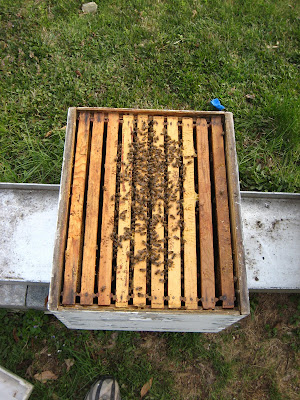
When using this method to raise queens it is imperative to open the colony and cut out any capped queen cells four days later. That is why this picture was taken four days after I made the split, because I'm getting ready to cut out the capped cells. First off, you must carefully inspect each frame for cells. Just a few bees gathered around a cell can hide it from your view so look very carefully. If the one capped cell gets by you it will hatch out first and kill your better queens.
Why does one cut out capped cells after four days? Wouldn't it be better if it hatched out so I could have a queen that much sooner? NO! It is very important that the new queen be fed a rich diet of royal jelly after it hatches into a larva from an egg. In order to ensure that your queen is reared from a very young larva you must cut capped cells at four days after making a split.On the fourth day after the egg is laid it hatches into a larva. Once it has been decided by the workers to raise a queen from it, it takes eight days from egg before the queen cell is capped. Queens can be raised from larvae as old as seven days. The larva between five and six days old are the ones we wish to eliminate by cutting out the capped cells four days after making the split.
What's wrong with a queens that was raised from a larva that was between five and seven days old? There is enough wrong with them that I shall continue cutting out the capped cells at four days. People commonly requeen their old queens with fresh quality queens annually. Why would you want a less than quality queen. Queens raised from larvae that are too old can lay fertilized eggs. However they have lower ovarian weight, are smaller, are weaker, lay less eggs, produce less pheromone and are therefore more aggressive, lay patchy or shotty brood patterns, are superseded rather quickly, just to name a few. These make bad queens because they were not continually fed royal jelly from the time they hatched until the time they were capped. If she lays fewer eggs than a quality queen then your going to get less honey because you have less bees.
Though this method of raising queens may produce what is referred to as "emergency queens", it does not imply that they are inferior. When they become inferior is when they are raised from larvae that is too old. This will produce what is sometimes called a "semi-queen" or "intercaste". These type of queens come from the true "emergency" cells. That is why we must cut out all capped cells after four days from making the split or nuc.
Pictured below are some queen cells along the bottom of the frame. These cells are still open and can be left alone.

I only found two capped queen cells that needed to be cut out. As you can see these cells are rather small in size and would no doubt make some small inferior queens.

Here is a picture of three queen cells from another split I made on the same day as the the one pictured above.

If you would like to sit up a colony to raise some queens please refer to my previous post on making a split. After you make the split do not add a queen or queen cell. Four days later go in and cut out the capped cells. If you only want four queens and they are making twelve, cut out some of the smaller cells. I like to do this because it makes me feel as if the queen cells remaining will receive more royal jelly than they would otherwise and that they end up being slightly better than they would otherwise. But when I make queen cells like the one pictured below I doubt if I'm going to start second guessing myself.

Though raising queens through this method is easy, you lose the ability to decide how many queens are raised and can not ensure they eggs were laid on the same day. The queen cells are also sometimes easily damaged when handling. When you graft you can virtually eliminate these problems which makes it a desirable skill to have. But if you only need a few at a time this is by far the easiest way to let the bees raise a queen.
























